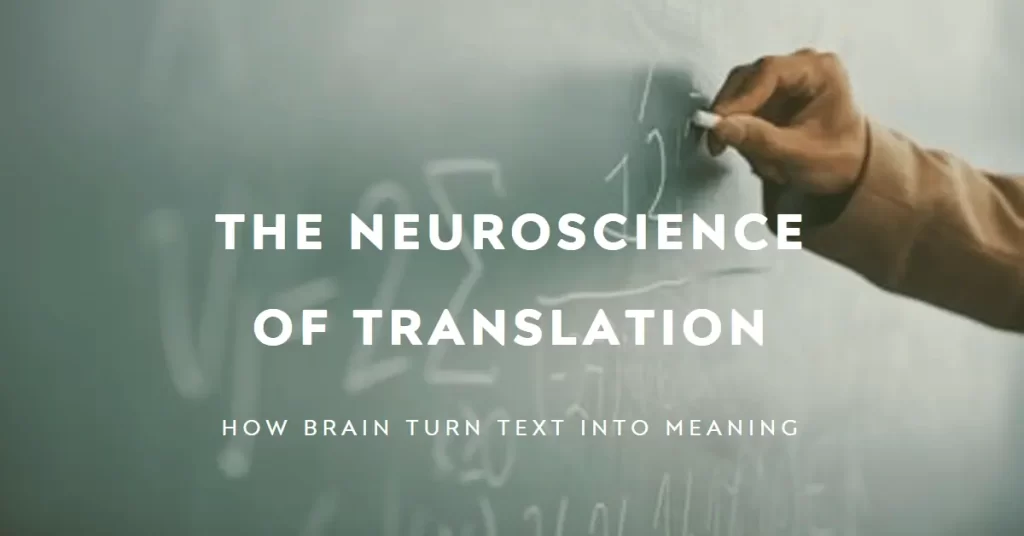Neuroscience of Translation – How Our Brain Turns Text into Meaning
Have you ever wondered how our brains transform mere words into rich layers of meaning? In a world where global communication is paramount, accurate translation plays a vital role in fostering understanding between cultures. The neuroscience of translation delves into the intricate workings of our brain as it processes language and context, unraveling the secrets behind this remarkable cognitive feat.
By grasping how the brain gives words meaning, we gain insight into the complex mechanisms that underlie accurate and meaningful translations. This understanding becomes crucial for bridging linguistic gaps and facilitating effective cross-cultural communication.
As we explore the depths of this fascinating field, we uncover the neural pathways responsible for deciphering languages and extracting nuanced interpretations from written and spoken words.
Join us on an illuminating journey through the neuroscience of translation, where we delve into the inner workings of our minds to unravel how language transcends barriers and connects us on a global scale.
Neuroscience of Translation – Language Processing and the Brain
The brain plays a crucial role in language processing, enabling us to turn words into meaning. Let’s dive into the key areas of the brain involved in this fascinating process.
- Overview of the brain’s role: The brain is responsible for both language comprehension and production. It processes information from written or spoken words, allowing us to understand and generate meaningful sentences.
- Key areas involved: Several regions contribute to language processing. The Broca’s area, located in the left frontal lobe, helps with speech production and grammar. On the other hand, Wernicke’s area, found in the left temporal lobe, aids in understanding language.
- Processing words and sentences: When we encounter words, they are initially processed by our auditory or visual cortex before being relayed to language-specific regions like Wernicke’s area. These areas decode lexical information and link it with semantic knowledge stored throughout the brain.
- Neural pathways and connections: Language processing involves intricate neural networks connecting various brain regions. For instance, the arcuate fasciculus connects Broca’s area with Wernicke’s area, facilitating communication between them during language tasks.
- Role of the right hemisphere: While language processing is primarily associated with the left hemisphere, studies show that the right hemisphere also contributes significantly to understanding context and meaning within sentences.
Understanding how our brains process language provides valuable insights into human cognition. By unraveling these neural mechanisms further, researchers can enhance our knowledge of translation processes at a fundamental level.
Now that we’ve explored how different areas of the brain work together for language comprehension and production let’s delve deeper into specific aspects related to neuroscience of translation: how context influences word meaning.
Context and Meaning in Translation – Cognitive Neuroscience
The neuroscience of translation delves into how the human brain turns words into meaning.
Understanding the impact of context is crucial for translators. The same word can have different meanings depending on its surrounding circumstances. Cultural nuances play a significant role in shaping these meanings, making it essential to grasp the cultural background behind the text being translated.
Translating idioms, proverbs, and cultural references presents unique challenges. These linguistic expressions are deeply rooted in specific cultures and may not have direct equivalents in other languages. Translators must navigate these obstacles by finding alternative ways to convey similar sentiments or adapting them to suit the target language.
To illustrate how context affects translation outcomes, consider the following examples:
- The English idiom “raining cats and dogs” would need to be adapted when translated into another language while preserving its figurative meaning.
- A historical reference that holds significance for one culture might require additional explanation when translated for readers from a different background.
Cultural competency is paramount for translators as it enables them to accurately convey meaning across languages. By understanding cultural norms, values, and beliefs, translators can effectively bridge gaps between languages while preserving intended messages.
Cognitive Processes in Translation
The process of translation involves various cognitive mechanisms that enable the brain to turn words into meaning. These cognitive processes play a crucial role in language comprehension and the accurate transfer of information between different languages.
Attention, memory, and decision-making are key components of the translation process.
Translators need to focus their attention on the source text while simultaneously accessing their knowledge of the target language. They must also rely on their memory to recall relevant vocabulary, grammar rules, and cultural nuances. Decision-making skills come into play when choosing the most appropriate words or phrases to convey the intended meaning.
Working memory is essential for both language comprehension and translation. It allows translators to temporarily store and manipulate information during the process. This cognitive function enables them to hold onto segments of the source text while formulating an appropriate translation in real-time.
Cognitive control plays a significant role in multilingual translation tasks. Translators need to switch between languages seamlessly, maintaining control over linguistic structures and lexical choices in each language. This ability requires cognitive flexibility and inhibitory control to avoid interference from one language while working with another.
Managing cognitive load is a challenge faced by translators. The complexity of translating multiple layers of meaning, cultural references, idiomatic expressions, and technical terminology can lead to increased cognitive load. However, strategies such as chunking information into manageable units, using mnemonic devices or visual aids, and taking breaks can help alleviate this burden.
Emotion and Translation
The neuroscience of translation explores how the brain turns words into meaning. One fascinating aspect of this field is the influence of emotion on language processing and translation.
There are several challenges that arise. Conveying emotions accurately in different languages can be difficult due to linguistic and cultural variations. However, strategies exist for capturing the intended emotional tone in translation.
Cultural differences play a significant role in both emotional expression and translation. Each culture has its own unique ways of expressing emotions, which can impact the translation process. Translators must navigate these differences to ensure that the emotional message is effectively conveyed.
To tackle these challenges, translators employ various strategies:
- Contextual understanding: Translators rely on their knowledge of cultural nuances to grasp the emotional context behind the text.
- Adaptation techniques: They use creative approaches to capture the intended emotional tone while considering linguistic and cultural constraints.
- Collaborative efforts: Working with native speakers or consultants helps ensure accurate interpretation of emotions across languages.
In addition to these strategies, translators may also face difficulties when encountering words or concepts that lack direct equivalents in other languages. This requires them to find suitable alternatives that convey similar emotions.
Understanding the neuroscience behind emotion and translation sheds light on how our brains process language and interpret meaning through an emotional lens. By delving into this field, researchers aim to enhance cross-cultural communication and bridge gaps between different languages.
Neuroplasticity and Language Learning
The brain’s ability to learn and adapt is a fascinating aspect of neuroscience.This capacity, known as neuroplasticity, plays a crucial role in how the brain turns words into meaning.
Neuroplasticity refers to the brain’s ability to reorganize itself by forming new neural connections throughout life. This process has significant implications for translation. As individuals engage in language learning, their brains undergo structural changes that enhance their translation skills and processes.
Language learning affects translation abilities in various ways. For instance, as individuals become proficient in multiple languages, they develop a deeper understanding of linguistic nuances and cultural contexts. This knowledge enriches their translations by capturing the subtleties that might otherwise be lost.
Bilingualism, which is fostered through language learning, offers numerous benefits for cognitive functioning. Research suggests that bilingual individuals demonstrate enhanced executive functions such as attention control and problem-solving skills. These cognitive advantages contribute to improved translation abilities.
To enhance language learning and translation abilities further, several techniques can be employed:
- Immersion: Surrounding oneself with the target language through activities like watching movies or reading books helps improve comprehension and fluency.
- Practice: Regular practice through conversation or writing exercises strengthens language skills.
- Vocabulary Expansion: Actively expanding vocabulary by learning new words and phrases enhances translation accuracy.
- Cultural Understanding: Developing an understanding of cultural nuances associated with different languages aids in producing culturally appropriate translations.
Technology and Translation
The role of technology in translation and language processing is undeniable. With advancements in technology, the field of translation has witnessed significant changes. Machine translation (MT) has emerged as a prominent tool, but it does have its limitations compared to human translation.
Machine translation relies on algorithms and databases to convert text from one language to another. However, it often struggles with context, idiomatic expressions, and cultural nuances. Human translators excel in understanding these intricacies and can provide accurate translations that capture the true meaning of the source text.
Despite the limitations of traditional machine translation, recent developments in neural machine translation (NMT) have shown promise. NMT utilizes artificial neural networks to improve automated translation by considering larger contexts and capturing more nuanced meanings. This advancement has led to improved accuracy and naturalness in translated texts.
The impact of technology on the translation industry cannot be underestimated. It has increased efficiency by automating certain tasks, allowing translators to focus on more complex linguistic aspects. Technology has facilitated global collaboration among translators through online platforms and tools.
Looking ahead, the future of translation lies in human-machine collaboration. While machines can handle straightforward translations efficiently, they still require human oversight for quality assurance. Human translators bring their expertise in understanding cultural nuances and adapting translations for specific audiences.
Ethical Considerations in Translation
Translators face numerous ethical challenges. Ensuring accurate and faithful translations while respecting cultural differences is of utmost importance. Let’s delve into some key ethical considerations in the field of translation:
- Cultural sensitivity and avoiding biases: Translators must be mindful of cultural nuances and avoid injecting personal biases into their translations. It is crucial to maintain a neutral stance and faithfully convey the intended meaning without distorting or misrepresenting it.
- Addressing political and controversial topics: Translating politically charged or controversial content requires careful handling. Translators should strive to maintain objectivity, accurately conveying the original message while considering potential sensitivities or implications.
- Ensuring accuracy and fidelity: Accuracy is paramount in translation. Translators must diligently research unfamiliar terms, consult subject matter experts, and cross-reference multiple sources to ensure precise translations. Maintaining fidelity to the original text while adapting it for the target audience is essential.
- Respecting cultural differences: Cultural diversity plays a significant role in translation ethics. Translators should be aware of different customs, beliefs, and values across cultures, ensuring that their translations do not offend or misinterpret these aspects.
- The importance of professional ethics: Upholding professional ethics is vital for translators. They should adhere to industry standards, respect client confidentiality, meet deadlines consistently, and continuously enhance their language skills through ongoing professional development.
Quality assurance also holds great significance in translation ethics. Proofreading, editing, and seeking feedback from clients or native speakers contribute to delivering accurate translations with linguistic finesse.
Conclusion
In conclusion, understanding the neuroscience of translation and how the brain turns words into meaning is crucial for various aspects of language processing. Language is processed in different regions of the brain, with each area playing a specific role in decoding and comprehending words. Context and meaning are essential factors in translation, as they help bridge the gap between languages and cultures.
Cognitive processes also come into play during translation, involving attention, memory, and problem-solving abilities. Emotions can impact translation outcomes, influencing the way words are interpreted and conveyed. Moreover, neuroplasticity plays a significant role in language learning, allowing individuals to adapt and develop proficiency in new languages.
Technology has revolutionized the field of translation, providing tools that aid in accuracy and efficiency. However, ethical considerations must be taken into account when utilizing technology in translation processes to ensure fairness and respect for cultural nuances.
To delve deeper into this topic or explore its practical applications, consider these frequently asked questions:
Frequently Asked Questions (FAQs) Section
Q1: Can understanding the neuroscience of translation improve my language skills?
Understanding how the brain processes language can enhance your language skills by providing insights into effective learning strategies and comprehension techniques.
Q2: How does context affect meaning in translation?
Contextual cues such as cultural references, tone of voice, and situational information greatly influence how words are understood and translated accurately.
Q3: Are there any cognitive benefits to being bilingual or multilingual?
Yes! Research suggests that being bilingual or multilingual can improve cognitive functions like attention control, problem-solving abilities, and even delay age-related cognitive decline.
Q4: What role do emotions play in translation?
Emotions can impact both the translator’s interpretation of text and how it is conveyed to maintain the intended emotional impact across languages.
Q5: Can technology replace human translators entirely?
While technology has advanced significantly in aiding translations, human translators still provide invaluable expertise.
Remember, the neuroscience of translation offers valuable insights into language processing and can have practical implications for language learning, cross-cultural communication, and translation practices and competences.




